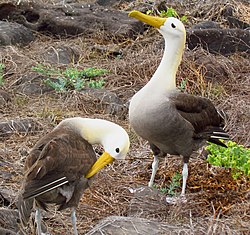Espanola (Isla Española or Hood Island) is one of Ecuador's Galapagos Islands.

Understand
[edit]As the most south-easterly island in the Galapagos, it is the oldest and the wildlife has had the most time to evolve.
Get in
[edit]Get around
[edit]See
[edit]Visitor sites
[edit]Punta Suárez
[edit]
A wet landing onto a beach with Sea Lions and Marine Iguanas leads on to a 2km trail through Masked and Blue-Footed Booby colonies (be careful not to step on them!) to some cliffs with a blow-hole. Beyond here is the Galapagos' only Waved Albatross colony - watch their somewhat clumsy attempts to take-off and land. Other animals including the Large cactus finch can also be seen.
Gardner Bay
[edit]Found on the northeastern part of Española Gardner Bay, a wet landing brings you to a magnificent long, white sandy beach, where colonies of sea lions laze in the sun, sea turtles swim offshore, and inquisitive mocking birds boldly investigate. The beach is considered an open area where you are free to explore and view land iguanas.
Snorkeling at Gardner Bay is fantastic. This is often your first chance to swim with the Sea Lions and this is an opportunity not to be missed. Further out towards Tortuga Rock and Gardner Island schools of large colorful tropical fish including yellow tailed surgeon fish, king angelfish and bump-head parrot fish swim along with an occasional Manta Ray gliding by and white-tipped sharks napping on the bottom.
Underwater sites
[edit]Islote Gardner
[edit]
This small island in front of Gardner Bay is lined with vertical cliffs that drop to sandy ledges and large boulders. Diving here you will encounter the smallest of the Galapagos garden eels, snake eels, blackspot morays, Galapagos putterfish, scorpionfish, and red-lipped batfish. On the north end of the island are twisting tunnels and to the south are caves making for interesting exploration. The area has an abundance of fish including schools of snappers, creolefish, king angelfish, butterflyfish, jacks, large pufferfish and a variety of sea urchins and sea stars.
Bajo Gardner
[edit]Normally the second dive at Española begins at the sea mount. Here, contrasting Islote Gardner, you will find some of the largest and least timid of the Galapagos garden eels. Tiger eels and red-lipped batfish are also common. Frequent encounters include eagle rays, hammerheads, schools of snappers, brightly colored peacock flounders, moray eels, whitetips, morays, king angel fish, creolefish, yellowtail surgeons, large Spanish hogfish, flag cabrillos and Panama graysbys.
Do
[edit]Buy
[edit]Eat
[edit]Drink
[edit]Sleep
[edit]Connect
[edit]Go next
[edit]The nearest islands are:
